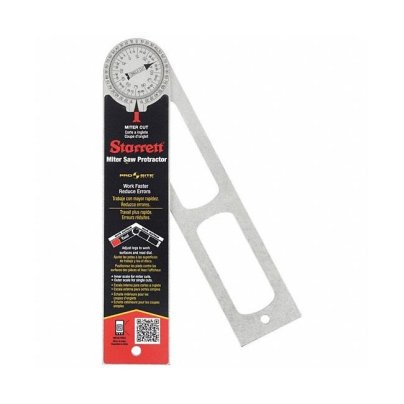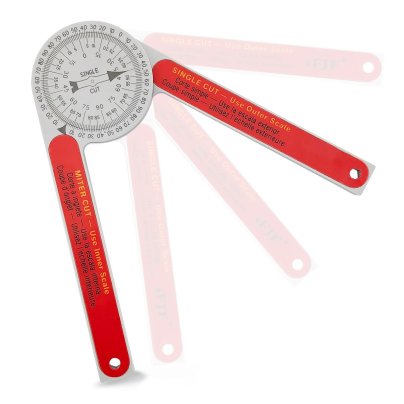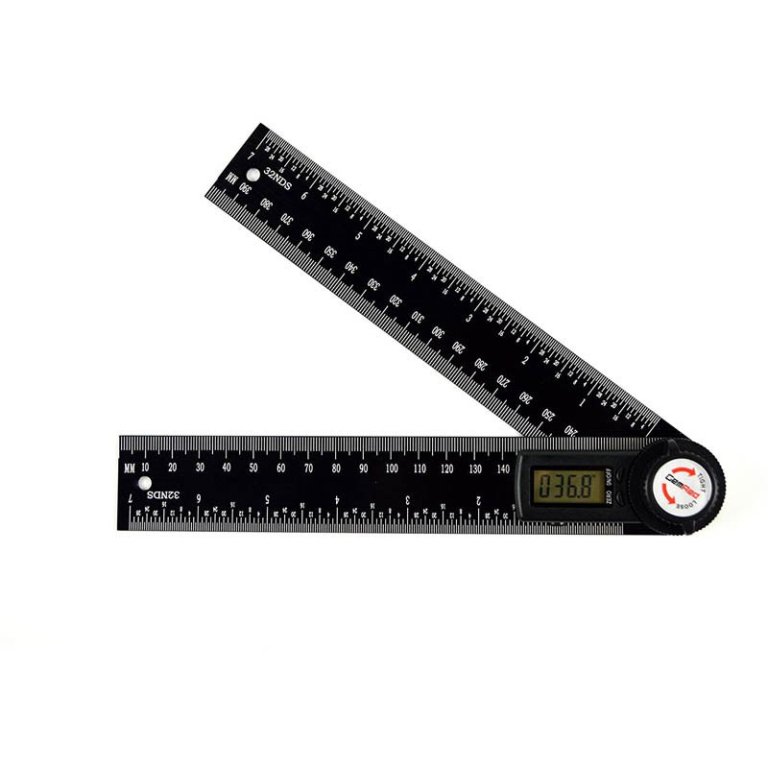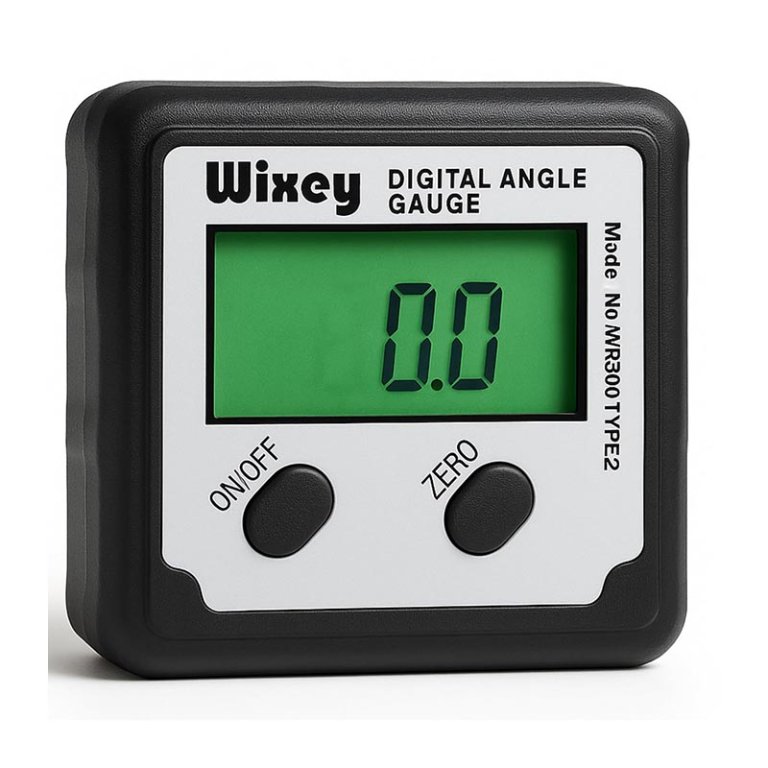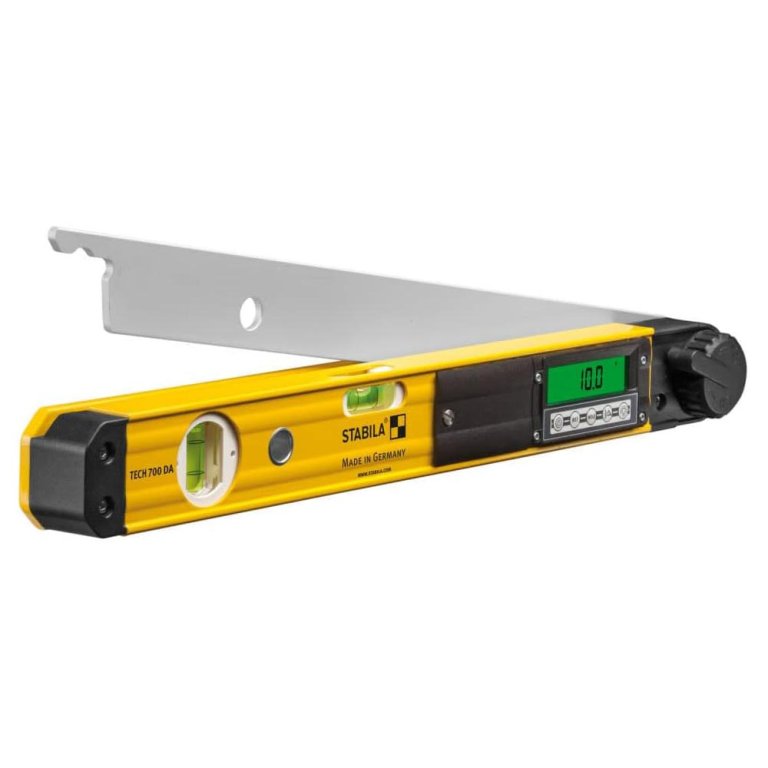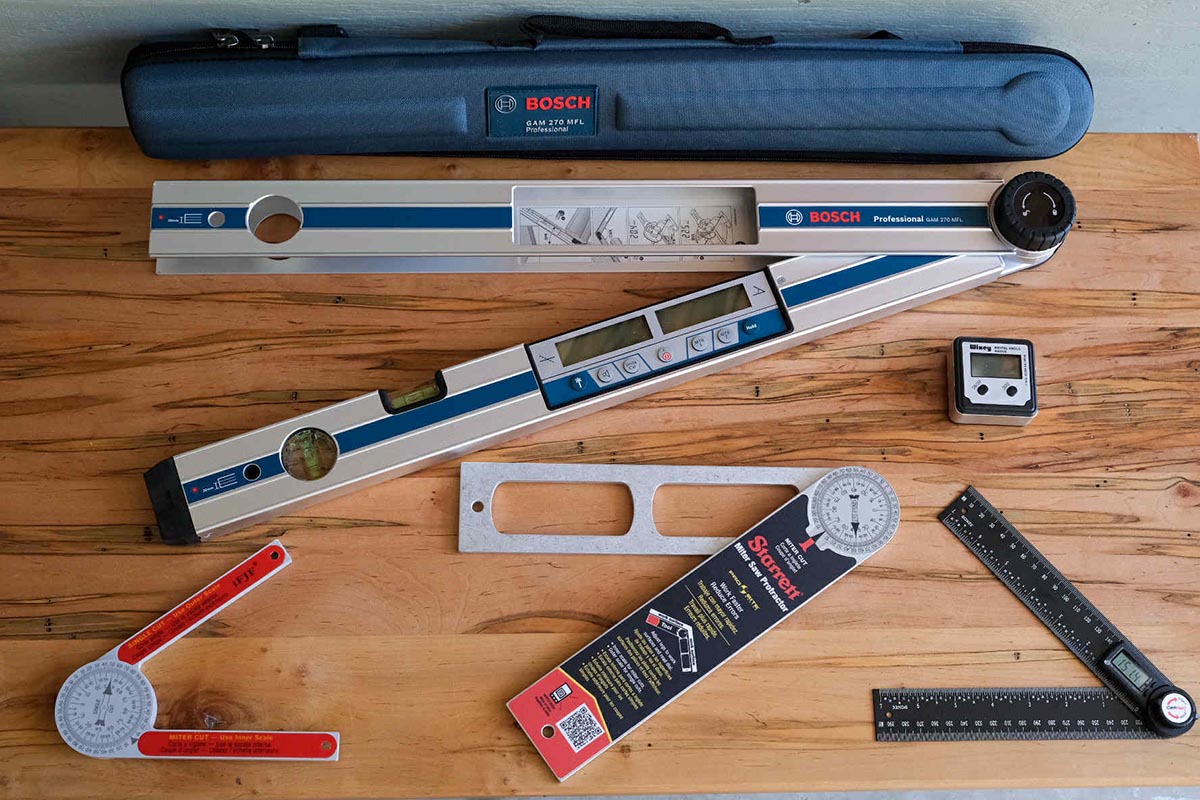
We may earn revenue from the products available on this page and participate in affiliate programs. Learn More ›
Whether you’re a DIYer installing crown molding, a woodworker tackling tricky angles on a custom bookshelf, or a contractor working on trim and framing, angle finders are essential tools for anyone who needs to measure or replicate precise angles. By taking the guesswork out of angled cuts, an angle finder saves time, prevents costly mistakes, and helps deliver highly accurate results.
Because accuracy and durability matter so much, we tested five different angle finders to determine which models performed best in terms of accuracy, usability, and long-term value. Our top recommendation is the Starrett 505A-12 Miter Saw Protractor, which stood out for its sturdy build, foolproof design, and consistently reliable readings. While digital models can run out of batteries and lower-cost versions can lose accuracy over time, the Starrett delivers reliable and repeatable results, making it an excellent choice for professionals and hobbyists.
In addition to the angle finders we tested, we also highlighted a few strong contenders we haven’t personally tested yet, such as the Woodpeckers Engle and the Stabila Tech 700, both of which have strong reputations among woodworkers. In the sections ahead, we’ll cover features such as digital displays for accuracy, hold function for transferring angles, and inside/outside angle measurement capabilities. Understanding what makes certain models stand out as the best angle finders will ensure you pick a tool that meets your needs and your budget.
- BEST OVERALL: Starrett 505A-12 Miter Protractor
↓ Jump to Review - BEST BANG FOR THE BUCK: GreatUs Miter Saw Protractor
↓ Jump to Review - BEST FOR BEGINNERS: GemRed 2-in-1 200mm Digital Angle Finder
↓ Jump to Review - BEST FOR PROFESSIONALS: Bosch GAM 270 MFL Professional Digital Angle Finder
↓ Jump to Review - BEST FOR SAW BLADES: Wixey WR300 Digital Angle Finder Gauge
↓ Jump to Review - BEST FOR WOODWORKERS: Woodpeckers 6” Engle Angle Finder
↓ Jump to Review - ALSO CONSIDER: Stabila Tech 700 Digital Angle Finder
↓ Jump to Review

Angle Finders Comparison
| Product | Type | Material | Length |
|---|---|---|---|
| Starrett 505A-12 Miter Protractor | Mechanical | Aluminum | 12 inches |
| GreatUs Miter Saw Protractor | Mechanical | Plastic | 7.28 inches |
| GemRed 2-in-1 200mm Digital Angle Finder | Digital | Aluminum, but also available in stainless steel | 15.75 inches |
| Bosch GAM 270 MFL Professional Digital Angle Finder | Digital | Aluminum | 26.9 inches |
| Wixey WR300 Digital Angle Finder Gauge | Digital | Digital | 2.3 inches |
| Woodpeckers 6” Engle Angle Finder | Aluminum body; stainless steel legs and knobs | Aluminum body; stainless steel legs and knobs | Arms: 6 inches; handle: 7.25 inches |
| Stabila Tech 700 Digital Angle Finder | Digital | Metal | 18 inches |

Our Top Picks
Accuracy matters. From crown molding to framing, these are our top picks for the best angle finders—tools designed to save time, reduce errors, and keep every cut precise.
Best Overall
Photo: GraingerWhat We Like
- Dual laser-engraved scales
- Full range (0 to 360 degrees)
- Easily converts measured angles to miter saw settings
- Measures inside/outside corners for crown molding, trim work
What We Don’t Like
- Compound cut conversion table not included
Specs
- Type Mechanical
- Material Plastic
- Length 7.28 inches
Our Ratings
| Ease of Use | 5/5 | Functionality | 4.8/5 | Durability | 5/5 | Value | 5/5 |
If all walls were 90 degrees, measuring angles would be easy. Not even new construction is always perfectly square—and in older homes, it gets worse. The handy Starrett Miter Saw Protractor is designed to be an angle-transfer tool. The Starrett reads a corner angle and instantly gives the exact setting for a miter saw.
The tool has two laser-engraved scales to make it easier to measure and transfer angles accurately: red for miter saw settings and black for the actual angle being measured. With both scales in the same place, it’s easy to convert a measured angle into the correct miter saw setting, thereby reducing guesswork and improving accuracy for complex cuts. Essentially, one scale reads the angle you’re measuring, and the other tells you how to set the saw to replicate it.
The pivoting Teflon O-ring gauge is easy to use, needs no batteries, has no LCD screen that can break, and it isn’t finicky in extreme temperatures like so many other tools in the toolbox.
If you need more than an angle transfer tool, consider the Starrett Prosite 5-1 protractor model, which has a compound cut conversion table allowing for more complex cuts often seen in crown molding installation or more complex angles that require miter and bevel cuts simultaneously. If you find yourself mainly needing an angle transfer tool with the occasional need for more complex angles, then this is the perfect tool for your toolbox. If needed, you can print the compound cut conversion table from Starrett’s online manual.
What our tester says: “I love how precise and easy to read the Starrett Miter Protractor is. I’ve used it repeatedly for setting up crown molding and trim work, and transferring angles. The measurements are clear, and it feels solid and well-built in my hands. I honestly reach for this tool every time I need a perfect miter—it makes setup faster, reduces mistakes, and gives me confidence that my cuts will fit just right.”—Cathy Harms, Product Reviews tester and writer
Get the Starrett angle finder at Amazon, Grainger, or Highland Woodworking.
Best Bang for the Buck
GreatUs Miter Saw Protractor
Buy at AmazonWhat We Like
- Many uses for a tool under $10
- Laser-engraved dial is easy to read
- Compact and lightweight
What We Don’t Like
- Made of flexible plastic
- Angle scale is difficult to read
Specs
- Type Mechanical
- Material Plastic
- Length 7.28 inches
Our Ratings
| Ease of Use | 4.5/5 | Functionality | 4.7/5 | Durability | 4.5/5 | Value | 5/5 |
The GreatUs Miter Saw Protractor saves time and reduces waste when making miter cuts, and it comes at an affordable price point. Manufactured from engineering plastic and featuring a laser-engraved dial, this protractor-type angle finder provides everything needed to duplicate miter angle measurements on baseboards, door and window casings, and crown molding miters.
Lightweight at just over 2 ounces, we found it easy to carry in a shop apron or tucked into a toolbox. The outer dial calculates single miter angles, while the inner dial calculates compound miter angles. Whether it’s held upside down or backwards, the GreatUs angle finder always gives a precise measurement, making it a great choice for trim carpenters or DIYers who want to install baseboard or crown molding and get a great fit on the corners.
This protractor does have a few drawbacks. The angle scale was a little difficult to read due to its small print and minimal contrast between the grey background and black numbers and lines. In addition, the instruction sheet and compound cut conversion table—printed on a separate piece of paper—uses small print that users may find frustrating to reference on the job.
Despite these minor shortcomings, the GreatUs Miter Saw Protractor remains an affordable, practical tool for DIYers and trim carpenters who need dependable results without the higher cost of premium models.
Get the GreatUs angle finder at Amazon.
Best for Beginners
GemRed 2-in-1 200mm Digital Angle Finder
Buy at AmazonWhat We Like
- Twist-dial locking mechanism
- Self-shutoff feature
- Functions as a ruler and a protractor
- Hold function keeps measurements saved until power-off
- Long-lasting battery
What We Don’t Like
- Tends to scratch easily
Specs
- Type Digital
- Material Aluminum, but also available in stainless steel
- Length 15.75 inches
Our Ratings
| Ease of Use | 5/5 | Functionality | 5/5 | Durability | 5/5 | Value | 5/5 |
For easily determining inside and outside angles on wall corners, the GemRed 2-in-1 Digital Angle Finder offers all the assistance a beginner needs. This protractor-type angle finder features a highly accurate digital readout as well as laser-etched metric and imperial markings on the ruler edges, which we found clear and easy to read.
We tested the GemRed Digital Angle Finder while working on wall corners, and it made figuring out both inside and outside angles much easier than we expected. As a beginner-friendly tool, it gives new DIYers the confidence to get accurate measurements without much fuss.
What stood out most to us was the digital readout. It’s highly accurate and gave consistent results every time in testing. We also liked the twist dial, which let us lock in the exact measurement once we had the ruler edges set in place. The aluminum edge guard has a slight rounding to it, so it felt safe in the hand, even when we were working quickly.
When we were done, the GemRed folded down neatly to about 7.5 inches by 2.4 inches, small enough to slip into a tool belt or even a shirt pocket. Weighing just 80 grams, it’s lightweight but still feels solid and reliable.
Get the GemRed angle finder at Amazon.
Best for Professionals
Photo: AmazonWhat We Like
- Four tools in one: finder, calculator, protractor, level
- Measures angles with a precision of ±0.1 degree
- Illuminated rotating display for easy reading
- Memory function stores angle measurements
What We Don’t Like
- Higher price point
Specs
- Type: Digital
- Material: Aluminum
- Length: 26.9 inches
Our Ratings
| Ease of Use | 5/5 | Functionality | 5/5 | Durability | 5/5 | Value | 4.8/5 |
After using the Bosch GAM 270 MFL Professional Digital Angle Finder, we can see why it’s considered a top choice for carpenters and construction pros. The five-in-one functionality makes it more than just an angle finder. Right away, we noticed how solid it feels—the durable aluminum housing makes us confident that it can handle jobsite abuse, and Bosch even claims it can withstand roof-height drops.
The two lighted digital displays were a huge plus. One shows the angle finder, the other the inclinometer, and together they made it easy to measure sloped surfaces—something we run into often when checking grades or roof pitches. We especially liked that the display flips automatically so it’s always readable, no matter how the user holds the tool.
The Bosch angle finder handled much more than simple angles during testing. It quickly calculated miter, bevel, and even compound bevel angles, saving us time when setting up saws. The memory function came in handy too—we were able to compare previously measured angles without second-guessing ourselves. And while we have separate levels in our kits, the built-in bubble level was nice for quick checks when we were setting shelves and appliances.
A feature we really appreciated was the grade measurement mode. Being able to toggle between degrees, percentages, or inches per foot on the fly meant we didn’t have to switch tools when checking slopes for roofs, ramps, or drainage. At 17 inches long, 2.4 inches wide, and weighing about 2.4 pounds, it’s bigger than a pocket tool but still manageable to carry around the site.
This isn’t just an angle finder—it’s an all-around precision tool that makes compound cuts and slope measurements a lot simpler. If your daily work involves tackling tricky angles or sloped surfaces, the Bosch GAM 270 MFL definitely earns its spot in the tool bag.
Get the Bosch angle finder at Amazon or The Home Depot.
Best for Saw Blades
Photo: AmazonWhat We Like
- Easy-to-read backlit screen
- Accurate tool for an affordable price
- Magnetic base secures firmly to saw blades
- Simple to use; just zero, tilt, and read
What We Don’t Like
- Doesn’t come with a storage case
Specs
- Type Digital
- Material Not listed
- Length 2.3 inches
Our Ratings
| Ease of Use | 5/5 | Functionality | 4.8/5 | Durability | 5/5 | Value | 5/5 |
We’ve been using the Wixey Digital Magnetic Angle Finder to measure blade tilt on table saw and miter saw blades, and it has become one of those small tools that makes a big difference. For setting blade tilt, the rare-earth magnet base locks firmly onto the blade, so we don’t have to worry about it slipping while zeroing in on the exact angle.
The green backlit screen is another feature we really appreciated. Even in a shop with sub-par lighting, the display is clearly readable without eye strain. It’s accurate, quick to respond, and simple to use—exactly what one would want when setting up for precise cuts.
Battery life has been solid, too, thanks to the auto shutoff. One AAA battery powers it, and we haven’t had to replace it often, even with regular use. The compact size—just 2.3 inches tall by 2.3 inches wide by 1.1 inches deep—means it can be used in tight spaces where other gauges won’t fit. We’ve also used it to measure slopes and reverse tilts, as well as to check for level and plumb, and it has handled every task without issue.
For us, the Wixey isn’t just a blade setup tool—it’s a reliable little angle gauge that has earned a permanent spot in our workshops.
Get the Wixey angle finder at Amazon or Rockler.
More Great Options
In addition to the angle finders we tested, we found several others that stood out for their features and positive user reviews. While we haven’t tested these ourselves, they seem to be excellent options for anyone seeking precise angle measurements.
Best for Woodworkers
Photo: AmazonWhat We Like
- Bisects angles so miter cuts fit much better.
- Foldable leg provides longer reference edge for alignment
- Expertly machined aluminum body with stainless steel legs.
- Wide measuring range covers most carpentry corner angles
What We Don’t Like
- Expensive compared to other angle finders
- Not a multitool; angle bisection and transfer only
Specs
- Type Mechanica
- Material Aluminum body; stainless steel legs and knobs
- Length hArms: 6 inches; handle: 7.25 inches
The Woodpeckers Engle Angle is definitely on my wish list. The design looks incredibly intuitive — you place it against two edges, adjust it to fit the corner, and it automatically gives you a precise bisecting line. That means no math or guesswork when cutting miters, which is ideal for trim work and picture framing. The build quality is outstanding, with a solid aluminum body and smooth movement in the stainless steel arms. It can easily become a go-to tool for anyone who values precision and craftsmanship in their projects.
Get the Woodpeckers Engle Angle Finder at Woodcraft or Woodpeckers
Also Consider
Stabila Tech 700 Digital Angle Finder
Buy at AmazonWhat We Like
- Multifunctional tool—a level, bevel, and digital protractor.
- Measures interior/exterior angles from 0 to 270°
- Digital display with backlit screen provides clear readings
- Angle bisector mode simplifies precise miter setup + cuts
What We Don’t Like
- Higher price compared to other digital angle finders
- Slightly bulky design limits access to tight corners
Specs
- Type Mechanica
- Material Aluminum body; stainless steel legs and knobs
- Length /
The Stabila digital angle finder offers impressive specs, features, and customer reviews. The precision it promises—plus or minus 0.1 degree — is outstanding, and means that this tool would be extremely useful for fine trim work, cabinetry, and furniture joinery where every cut matters. The combination of digital angle measurement, spirit level, and bevel gauge in one tool reduces the number of tools to carry and speeds up layout work. The electronics mean this angle finder is dependent on batteries, so keeping extras on hand is necessary. Still, for a professional who values speed, accuracy, and reliability, it’s a solid investment that could enhance high-precision projects.
Get the Stabila digital angle finder at Amazon
Jump to Our Top Picks


How We Chose and Tested the Best Angle Finders
To determine the best angle finders, we began by considering over a dozen products from leading tool companies and narrowed the list to the top performers. Our testing focused on key features users care about most: price, battery life, accuracy, ease of use, display readability, and durability. Additional functions, such as a hold function, zeroing, and memory features, were evaluated to assess their effectiveness in practice. Each product was compared directly across these criteria to determine which ones stood out. For example, the Starrett Miter Protractor earned top marks with 5/5 ratings in ease of use, durability, and value, while the Bosch GAM 270 MFL Digital Angle Finder stood out with near-perfect scores across the board. Finally, each angle finder was used for a variety of carpentry tasks, like measuring a wall angle and transferring the angle to a miter saw. We also used the angle finders for saw blade alignment, and measuring miter angles and slopes/tilts.
| Product | Ease of Use | Functionality | Durability | Value |
|---|---|---|---|---|
| Starrett 505A-12 Miter Protractor | 5/5 | 4.8/5 | 5/5 | 5/5 |
| GreatUs Miter Saw Protractor | 4.5/5 | 4.7/5 | 4.5/5 | 5/5 |
| GemRed 2-in-1 200mm Digital Angle Finder | 5/5 | 5/5 | 5/5 | 5/5 |
| Bosch GAM 270 MFL Professional Digital Angle Finder | 5/5 | 5/5 | 5/5 | 4.8/5 |
| Wixey WR300 Digital Angle Finder Gauge | 5/5 | 4.8/5 | 5/5 | 5/5 |
What to Consider When Choosing an Angle Finder
When choosing an angle finder, start by considering accuracy, functionality, and the type of angles you’ll measure. Think about your intended application and extra features you might need, such as a magnetic base, locking function, or display type.
The first choice is between digital and mechanical models. Digital angle finders offer high precision (often ±0.2 degrees), backlit LCDs, zeroing functions, and magnetic bases, making them ideal for woodworking and carpentry. Their drawbacks are higher cost and battery dependence. Mechanical models, such as T-bevels or manual protractors, are simple, inexpensive, and require no power, making them great for transferring angles, though they are less precise.
Choose a tool suited to your projects: angle cubes for saw blades, hinged digital protractors for corners, or inclinometers for slopes. Durability matters, so we suggest choosing materials like stainless steel or aluminum.
Types of Angle Finders
Digital
Digital angle finders are precision tools designed to give fast, accurate readings. They come in two main styles: box-shaped digital angle gauges and hinged-arm models. Box-shaped gauges have a magnetic bottom, making them ideal for placing directly on saw tables or miter saw fences. Hinged-arm digital models function like a protractor, with two arms joined at a pivot, allowing users to measure angles between surfaces. Digital angle finders often feature backlit digital displays or low-light conditions and can measure angles with precision up to 0.1 degrees. Additional features can include a memory function to store measurements.
Mechanical/Analog
Mechanical angle finders are simple, precision tools that rely on pivoting arms or protractors to measure and transfer angles. These angle finders are easy to use, durable, and do not require batteries. The simplicity of the design makes it long-lasting and durable. Craftspeople appreciate mechanical angle finders for their simplicity: they require no batteries, are rugged on job sites, and are easy to use. Whether fitting trim, building furniture, or checking or transferring angles to a miter saw, a mechanical angle finder is a dependable and practical tool.
Accuracy and Measurement Range
Most digital models offer an accuracy range of ±0.1 to ±0.3 degrees, which is more than enough for precise woodworking, carpentry or DIY home improvement projects. Manual angle finders may not be as precise, since they rely on the user’s ability to read the scale correctly.
For small DIY projects, a ±0.3-degree tolerance is acceptable as angles will still fit together well, but if you’re a professional carpenter or woodworker, you’ll want a tighter ±0.1-degree accuracy that digital models provide to ensure repeatable, high-precision results.
The measurement range is another consideration. Digital angle finders often cover ±180 degrees, while manual models typically handle 0 to 180 degrees. Choosing the right tool for your project and the angles you plan to measure can save time and reduce errors.
Display
If you find yourself squinting at a tiny scale, struggling to read your angle measurement, then the display on a digital angler finder may make a big difference. Most models come with backlit LCD screens so that you can see measurements clearly, even in a dim workshop or on a dusty jobsite. Some digital angle finders have dual displays, letting you check both the angle and slope at the same time—handy for compound cuts or roof pitches.
The digital display typically provides precise measurements down to 0.1 degrees, and many displays include extra features such as backlighting and memory functions for comparing angles across a project. This takes the guesswork out of your setup and keeps your work more accurate.
Compare that to a mechanical angle finder, where you’re reading tiny engraved scales. While they’re durable and simple to use, they can be tricky to read and easy to misinterpret. A clear display can save you time, reduce mistakes, and make measuring angles a much smoother, stress-free process.
Material and Durability
Nothing ruins a project faster than a tool that can’t take a little abuse. That’s why material and durability are key when picking an angle finder. High-quality models often feature aluminum and/or stainless steel, giving them the strength to withstand knocks, drops, and everyday wear and tear. Some professional-grade digital angle finders even offer ingress protection, meaning they’re resistant to dust and liquids. An ingress rating of IP54 is a good standard for most users who do general carpentry and work on construction sites.
Impact resistance is another crucial factor. Many tools are designed to survive accidental drops from workbenches or even roof height. Water and dust resistance also help prevent wear and and tear as well as short circuiting, extending the life of the tool significantly. A sturdy tool not only lasts longer but also performs consistently, saving you frustration and keeping your projects on track.
Additional Features
Looking for an angle finder that does more than just measure? Many digital models come with additional features that make life in the shop a lot easier. One of the most useful is a memory function, which lets you store and recall previously measured angles so that you can maintain consistency across multiple cuts.
Some angle finders (like the Bosch we reviewed above) include angle conversion, allowing you to switch between degrees, percentages, or inches per foot, which comes in handy when working on roofs or ramps. A built-in inclinometer is another feature that helps measure slopes and pitches precisely.
Other features may include auto shutoff to save battery life, dual displays to see angle and slope simultaneously, and backlighting for low-light conditions. These extra features transform a simple measuring tool into a versatile, time-saving device for pros and DIYers alike.
Other Tools for Finding Angles
When it comes to measuring angles, digital and manual angle finders aren’t your only options. Traditional tools like the pivot square offer a simple way to measure and transfer angles with adjustable arms and a pivot point. Similar to a speed square, the pivot square offers more versatility for complex angles. The multi-angle speed square is another tool that can help mark right angles quickly and accurately, making it a staple for framing, trim work, or layout tasks. This multi-angle speed square has a base with an adjustable arm designed to “shoot” or mark 90-degree angles.
For more flexible angle work, the bevel gauge, or sliding T-bevel, is a classic tool. It has an adjustable blade that lets you copy or set any angle, perfect for custom joinery or transferring angles from one piece to another. Similarly, a miter guide attaches to saws or worktables, allowing precise angled cuts without complex measurements.
While these tools may lack the digital precision or memory functions of modern angle finders, they remain highly valuable for quick layouts, rough cuts, or situations where electronic angle finders aren’t practical. Many carpenters and woodworkers use a combination of traditional and digital angle finders to balance speed, accuracy, and versatility on the job.
How to Use an Angle Finder
Getting accurate angles doesn’t have to be a headache, and an angle finder can make the job a lot easier. Whether you go digital or choose a mechanical angle finder, the key is knowing how to read it properly and set it up correctly. Digital models give you precise readings on a screen, often down to a tenth of a degree, while manual tools require you to line up the arms and read the scale carefully. Either way, taking the time to set it up right makes a big difference. Fortunately, angle finders are easy to use following these basic steps:
- Zero it first. Place it on a flat surface and set it to zero to make sure your readings are accurate.
- Align the arms. For hinged or pivot models, match each arm to the surfaces you’re measuring.
- Read the measurement. Check the digital display or manual scale, and take note if the angle is measured in degrees, percent, or another unit. Always double-check your zero point before reading any angle, especially on digital tools.
FAQs
Whether you’re a carpenter, woodworker, or DIY enthusiast, angle finders are essential tools for preparing precise cuts, accurate slopes, or perfectly measured angles. In this FAQ section, we’ll explore how both digital and manual angle finders work, how to read measurements correctly, and what determines their lifespan. You’ll also get tips on maintaining your tool and maximizing its accuracy over time.
You place the tool’s arms along the two surfaces forming an angle, and it instantly displays the correct angle measurement. Some digital versions have magnets and use a sensor to detect the angle relative to gravity.
You do not need protective gear to use an angle finder, as it is a harmless measuring tool. But if you’re working around power tools such as saws, hearing and eye protection is recommended while operating them.
A mechanical angle finder can last for decades, as its lifespan depends on its physical durability. A digital angle finder typically lasts for years, limited by its electronic components and battery life.
Meet the Tester
Cathy Harms is an award-winning woodworker, carpenter, and writer who began working with Bob Vila in 2024. Tapping into more than a decade of experience in the skilled trades, she covers topics ranging from fine woodworking and furniture making to home improvement and tool reviews. Cathy brings a unique blend of fine craftsmanship, teaching expertise, and passion for empowering others in the trades and home improvement.
Additional research provided by Glenda Taylor.
